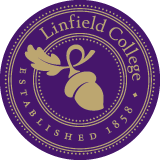Linfield University
 |
|
| Motto | Connecting Learning, Life, and Community |
|---|---|
| Type | Private |
| Established | 1858 |
| Affiliation | Historic and symbolic ties to American Baptist Churches USA |
| Endowment | $103.5 million (2014) |
|
Academic staff
|
157 |
| Students | 2,466 (2014) |
| Undergraduates | 1,683 (McMinnville Campus) 347 (Portland Campus) 436 (Adult Degree Program) |
| Location |
McMinnville, Oregon, USA 45°11′56.4″N 123°11′55.3″W / 45.199000°N 123.198694°WCoordinates: 45°11′56.4″N 123°11′55.3″W / 45.199000°N 123.198694°W |
| Campus | Rural, 193 acres (78 ha) (McMinnville) |
| Colors | Cardinal and Purple |
| Athletics | NCAA Division III |
| Nickname | Wildcats |
| Website | linfield.edu |
Linfield College is an American private institution of higher learning located in McMinnville, Oregon. As a four-year, undergraduate, liberal arts and sciences college with a campus in Portland, Oregon, it also has an adult degree program located online and in eight communities throughout the state. Linfield Wildcats athletics participates in the NCAA Division III Northwest Conference. There are a combined 2,466 students at Linfield, which employs more than 150 full-time professors.
Linfield traces its history back to 1849 when the Oregon Baptist Educational Society was created in Oregon City. That group organized in order to start a Baptist school in the region, which started as Oregon City College in 1849. In 1855, Sebastian C. Adams began to agitate for a school in McMinnville. Adams and his associates were members of the Christian Church, and so the school became a Christian School. To begin, 6 acres (2.4 ha) of property were donated by W. T. Newby and a group was formed to establish the school. The group included William Dawson, James McBride, Newby, and Adams and they bore the major part of the expenses of starting the school. These men built a building and convinced Adams, who was a teacher, to operate the school. After about a year and a half and because of the difficulty of running the school alone and funding problems, Adams suggested that the school be turned over to the Baptists who were attempting to start up the West Union Institute that had been chartered in 1858 by the Oregon Territorial Legislature. The Adams group imposed the condition that the Baptists keep at least one professor employed continuously in the college department. Other accounts indicate that the Baptist group purchased the land in 1857 in order to start their school. The Baptist College at McMinnville was chartered in 1858 by the Oregon Territorial Legislature, and later became McMinnville College before acquiring its current name.
In 1922, the name was changed to Linfield College in memory of a Baptist minister, the Rev. George Fisher Linfield whose widow, Frances Eleanor Ross Linfield, gave a substantial donation to the college to promote Christian education and as a memorial to her late husband. Mrs. Linfield served as Dean of Women from 1921 to 1928, and sat on the Board of Directors from 1922 to her death in 1940. Her gift included real estate in Spokane, Washington, valued at $250,000. In his 1938 book, Bricks Without Straw: The Story of Linfield College, Professor Jonas A. "Steine" Jonasson quotes from the minutes of the college's board of trustees to explain Mrs. Linfield's motivation for her large land gift to the college: "Mrs. Linfield's dual purpose in making the gift to McMinnville College was to 'perpetuate the name, scholarly attainments and Christian influence of her late husband, Rev. George Fisher Linfield, and to promote the cause of Christian education.'"
...
Wikipedia
